
Yesterday, Italian Minister of Culture Dario Franceschini announced revolutionary changes for State museums across all of Italy. These will impact the Uffizi Gallery.
The major change is that free tickets will only be available for those under 18 years old (and a few other groups, such as teachers) and reduced tickets for those under 25 years old. Everyone else will be paying a full entry ticket. This means that all over 65 years old will now be paying entrance. Precise details are being worked out and will be updated before the end of the month.
The second major change is that every first Sunday of the month state museums will be free for everyone as part of the initiative “Sunday at the Museum“.
Another change announced as part of the Ministerial decree signed and announced yesterday is that there will be two annual “Nights at the Museum” every calendar year, where entrance only costs a euro (as it did in this last edition in May) and opening times extend late into the night while all major museums, including the Uffizi Gallery, will have extended opening times until 10pm every single Friday evening.
To view a full list of state museums in Florence, go here.
To view the list of all state museums in Tuscany, check the Ministerial website here.
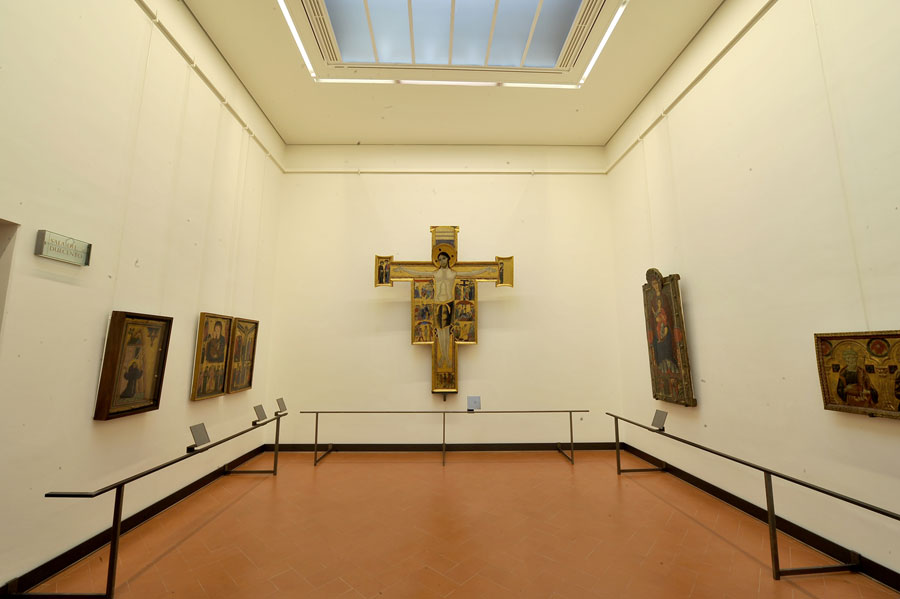
After a long period of renovation work, Hall 1 on the top floor of the Uffizi Gallery reopened today. The hall is to the right as soon as visitors arrive on the second floor at the sart of the First Corridor; from today, the hall hosts 9 paintings from the second half of the 12th century to the end of the 13th century that were displayed in Hall 2 previously.
As works to renew and update the entire museum continue, visitors will be able to enjoy these works by Florentine and Tuscan painters in chronological order with the rest of the succeeding halls that lead to one into early Medieval works by Cimabue, Giotto and Buoninsegna. The works often were overshadowed by the great works in Hall 2, so in this new space they should receive more attention.
The hall used to house marble works from the Ara Pacis and was known as the “Archeological Room”. The entire room, from the floor to the sunroof, was renovated, and has a new air conditioning, security and lighting systems.
Don’t forget to start your visit here!
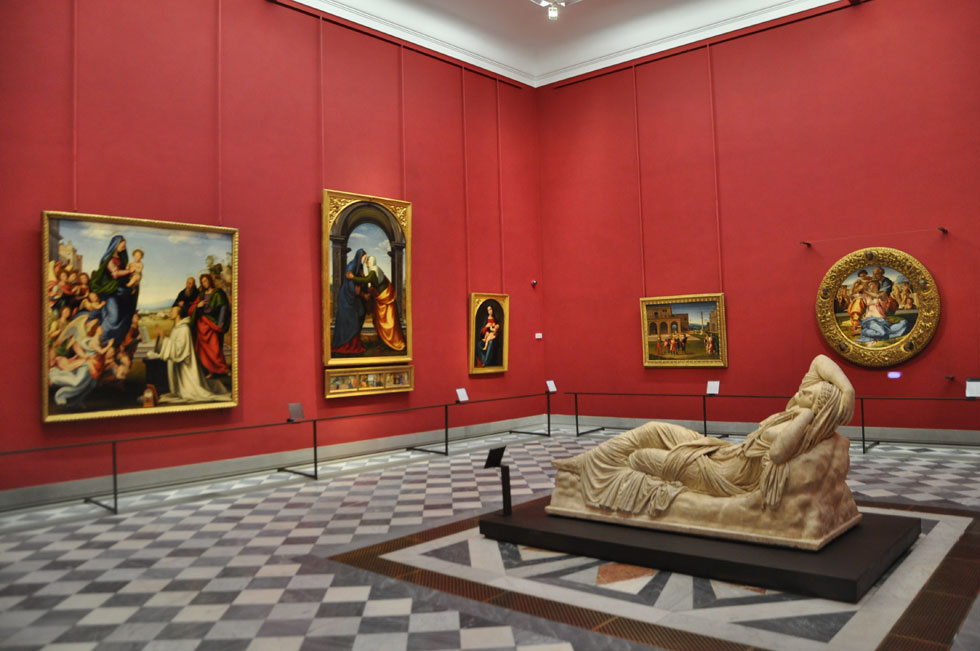
On Monday June 2, the Uffizi Gallery will have an extraordinary opening given the holiday and the large amount of visitors to Florence during the 3-day weekend.
The museum will remain open following its usual hours, from 8:15 am to 6:50pm.
Enjoy the holiday!
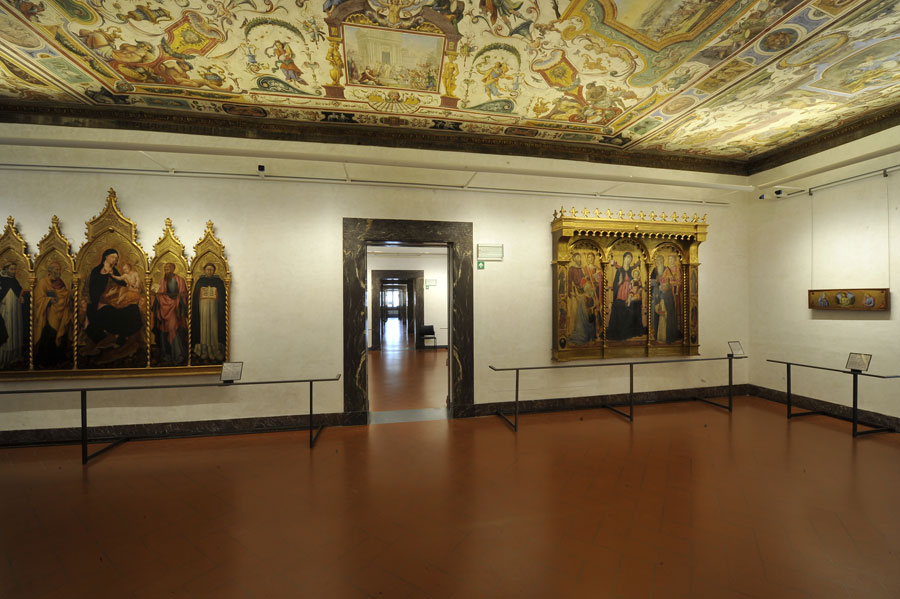
Visitors to the Uffizi this morning might not have known as they visited but the five rooms (halls 19-23) that immediately follow the Tribune have just been re-opened today after an extensive renovation.
The five rooms, called the “salette” in Italian, are now dedicated to masterpieces from Italian artists from the early Renaissance in the 15th century. There are works by Sienese artists in the first room, Hall 19, including a beautiful Madonna in Throne with Saints by Vecchietta. The next hall, Hall 20, is dedicated to Mantegna, Bellini and Antonello da Messina where you will, among others, admire a beautiful Madonna of the Cave by Mantegna set on a light green background panel. Hall 21 is dedicated to Venetian painters, including works by Giovan Francesco Caroto and Cima da Conegliano while Hall 22 is dedicated to painters from Emilia Romagna and the last hall, 23, is dedicated to painters from Lombardy.
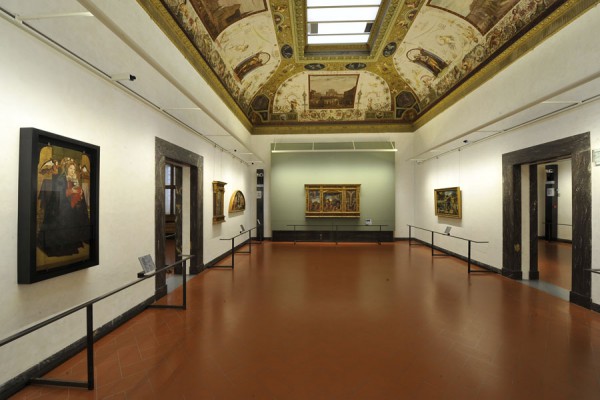
Hall 20 – Mantegna, Bellini and Antonello
The new rooms host a total of 44 works, 12 of which are paintings that have been chosen from the large deposit of works owned by the Uffizi Gallery but which were not on display before.
Among the most beautiful works of art on display are the ceilings, whose “grottesque” decorations by Lodovico Buti date back to 1588. The rooms, from the end of the 16th century up until 1775, housed the Medici Armory. The ceilings of the first two rooms were completely redone in the middle of the 17th century but the other 3 still contain their original designs which include scenes of battles and other armory-related scenes. The armory was in part moved to the Fortezza da Basso, in part dismembered and sold in 1780 when Pietro Leopoldo added the rooms to the museum. Only then did the rooms host paintings by Flemish artists such as Rubens and Rembrandt, designs by Raffaello and prints by Dürer. The prints and designs through the years were moved, while the paintings continued to be displayed here up until the rooms were closed for renovations last year. Many of the paintings have moved or will be soon on display in other of the new rooms opening up at the Uffizi.

Florence, August 1944 – the devastation of the river streets and buildings after the bombing of the bridges
Some of the decorations on the ceiling of hall 21 was destroyed during the bombing of the streets and bridges along the Arno river by the Germans in 1944. In memory of this event and based on a design by Vittorio Granchi, a new mural painting was made in this spot representing the area after its destruction, with the date “August 1944”. Make a note so you can look for it yourself!
The rooms are part of the most ancient section of the Gallery. After the Tribune, these are the first rooms in this area to be entirely modernized, thus beginning the most challenging aspect of the New Uffizi project: renovating the main nucleus of the museum without ever closing the entire museum to the public.
The air conditioning systems are brand new, with integrated humidifiers, while the entire electrical and lighting systems were redone, taking advantage of new LED technology for both direct and indirect lighting, and new security alarm systems are in place.
The photographs here are just a taste of the new rooms: we hope you can enjoy them in person soon!
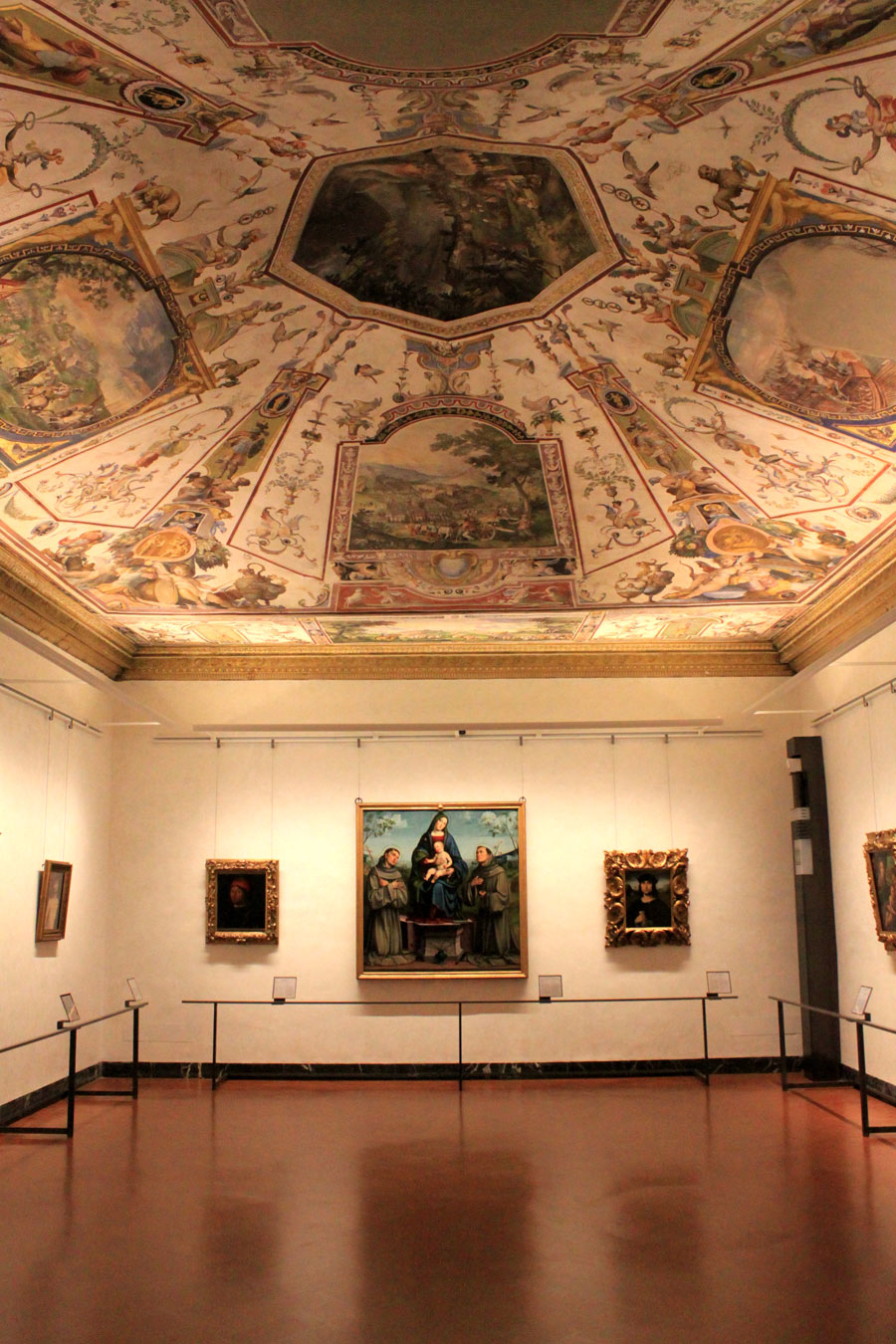

Until April 12, if you visit the Uffizi Gallery on Saturday afternoons, you can join in a short free tour of the “yellow” rooms, halls restored and open to the public a few months ago as part of the New Uffizi project.
The visits are at 2:30pm, 3:30pm and 4:30pm of the rooms dedicated to Florentine and Sienese painters from the 17th century which are located on the first floor in Halls 95-100. If interested, head directly to Hall 95 a few minutes before the start of the scheduled times. Enjoy discovering these new halls!
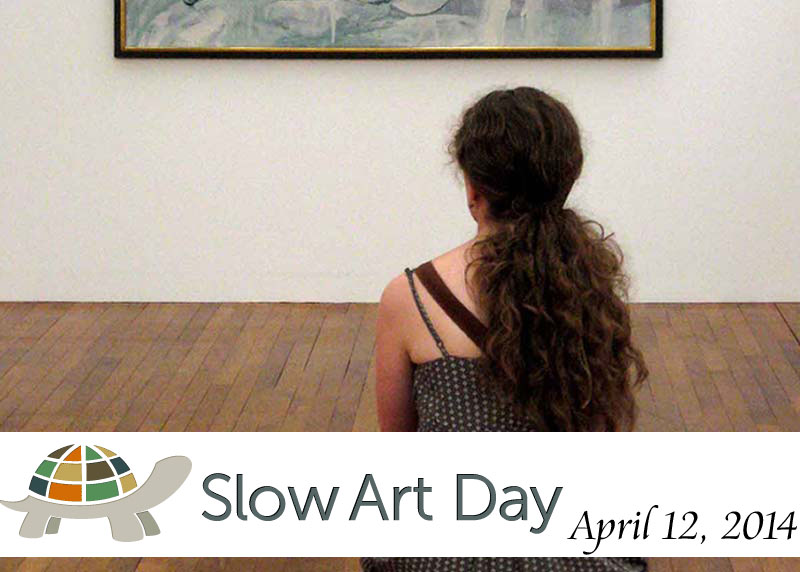
If you’re in Florence this April 12 – and it isn’t the first time you visit the Uffizi Gallery – you could join in onto a different type of visit to the museum, a SLOW visit on Slow Art Day.
If you’ve never heard of Slow Art Day, don’t worry as the global, all-volunteer event is just in its 4th year but with the number of venues increasing every year as the idea takes root of taking your time to visit a local museum. This will be the first time an event is being organized at the Uffizi Gallery; make note that it is not an “official” event although the gallery administration does know it will be taking place.
So how do you visit the Uffizi Gallery slowly? The idea of the movement is for everyone to go visit a local museum on April 12 at 11am worldwide, study 5 specific works of art designated by the host and then meet up with the host and others participating in the event over lunch to discuss your impressions.
The Uffizi is clearly not easy museum to visit “slowly” given the amount of extraordinary masterpieces it contains but local guide and native, Elena Fulceri, has taken on the challenge of acting as host. Anyone wishing to take part in the completely free event (you just pay for your ticket to the museum and your own lunch afterward) needs to register through EventBrite here.
This event is recommended for anyone who has already been to the Uffizi and wishes to study 5 works of art that are not considered among the most famous in the museum’s collection. Registered participants should receive information on which ones will be studied a few days before the event.
If request is high enough for the event, Elena will organize another session in the afternoon at 3:30pm. I’m signed up for 11am to go see these “off the beaten path” works of art slowly, as it is likely I have not stopped to look at them closely before. See you there!
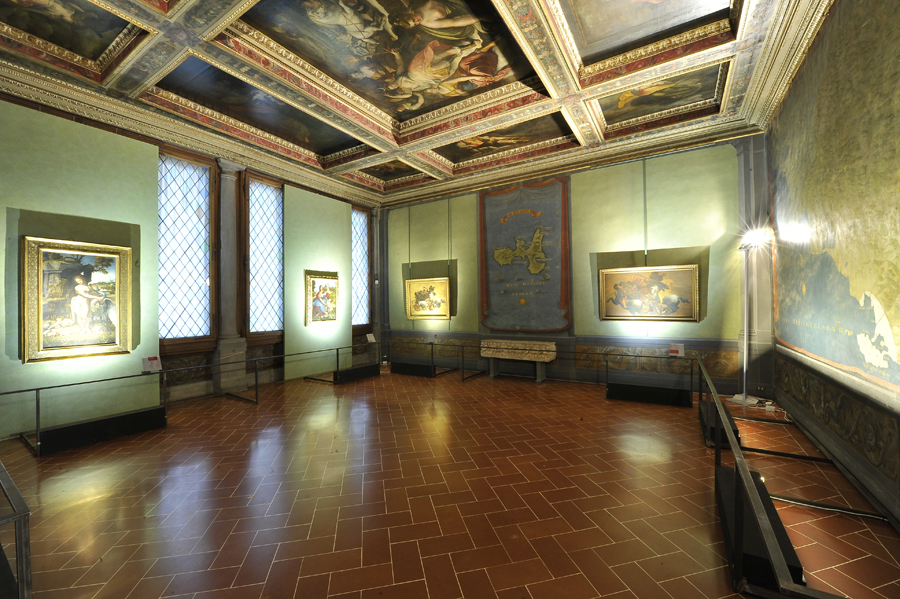
Starting tomorrow, March 25, visitors will have almost 100 days in which to enjoy a very special temporary viewing at the Uffizi Gallery of several works inspired by Leonardo da Vinci in a room normally closed to the public, the Room of Geographic Maps.
From March 25 through June 29, 2014, the Room of Geographic Maps which houses precious frescoes by Stefano Bonsignori of the territories of the Tuscan Grand Duchy located next to Hall 15, hall dedicated to Leonardo da Vinci, will have 4 paintings that are copies or derivative from original works by Leonardo: the “Leda with Swan“, “Virgin with Child and St. Anne” and 2 wooden panels showing the “Fight for the Flag“, copies from the mural painting by Leonardo for the “Battle of Anghiari” for Palazzo Vecchio in 1503. 
In particular, the temporary exhibit is to welcome the arrival of the “Tavola Doria” to the Uffizi, one of these two wooden panels showing a part of the Battle of Anghiari. The work of art was illegally taken from Italy and returned in 2012 as a donation from the Fuji Art Museum in Tokyo. As part of the agreement for the permanent return of the work to Italy, the Tavola Doria will return to Japan at the end of June and remain there for 4 years before it definitely remains at the Uffizi so this a very special occasion to admire the work in Florence.
The Tavola Doria has been restored by the Opificio delle Pietre Dure since its return to Italy in 2012. It has been in Rome, Anghiari and Florence since then at special exhibits.
The exhibit is a chance to also admire the room, normally closed to the public, as well as 3 other works inspired by Leonardo as the master in the 15th century that inspired many other young artists. While the Tavola Doria might not be an exact duplicate, it calls into mind the essence of that Battle of Anghiari that Leonardo created but left no trace of. This is a chance to admire extraordinary works in this special context.
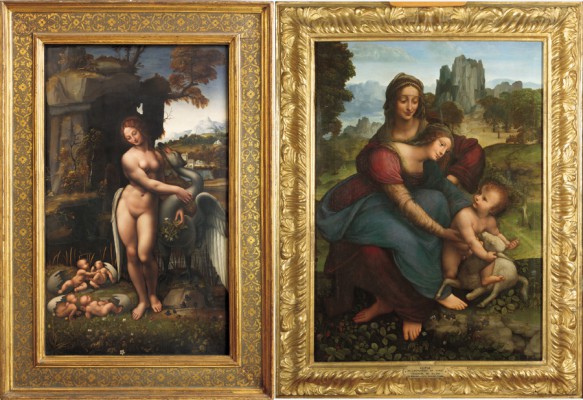
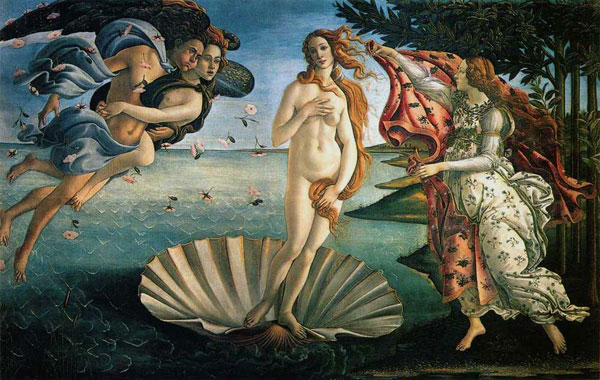
All visitors to the Uffizi Gallery should expect to see some form of nudity or other in the classical Roman and Greek sculptures as well as paintings, from Botticelli’s Birth of Venus to Titian’s Venus of Urbino.
This past Saturday, visitors to the Uffizi got an unexpected display of nudity, inspired precisely by Botticell’s masterpiece. A 25-year old Spaniard, in front of Botticelli’s “Birth of Venus“, quickly striped naked and proceeded to kneel and drop rose petals in front of the painting while exclaiming “Es arte, es poesia” – “it’s art, it’s poetry”!
The Uffizi Gallery director, Antonio Natali, commented: “Yes, I was told of what happened. What can I say? In a million and 900 hundred visitors a year, there are people who are disturbed, restless, passionate… and he must have suffered the syndrome of Adam….”. The director jokes as there was no damage and the custodians were quick to intervene.
The young man was calm as he dressed again and as he was accompanied out of the museum by local police. He was charged with indecent public exposure.
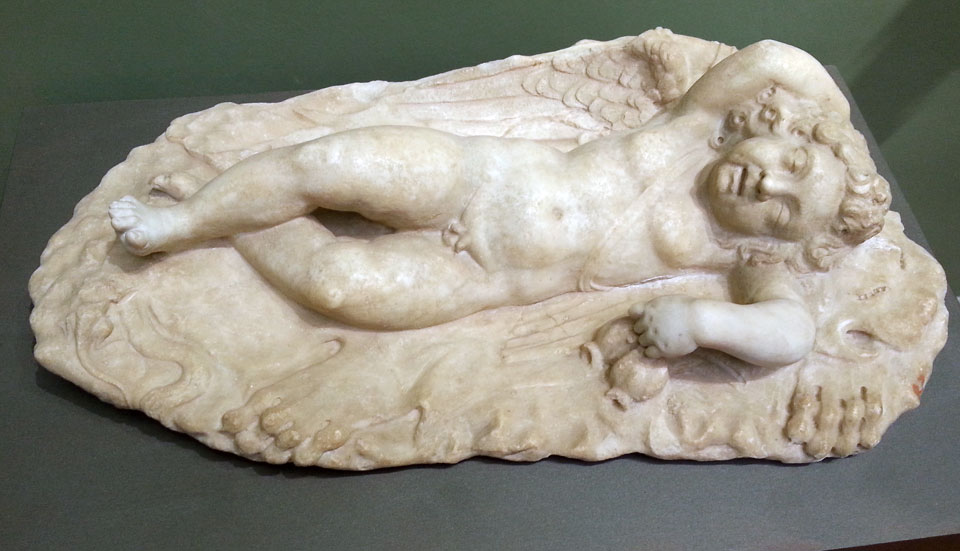
As part of the celebrations in commemoration of the 450th year since Michelangelo’s death, the Uffizi has opened up 2 more rooms under renovation for the last year as part of the New Uffizi project today February 17. A much more enjoyable way for all who visit the Uffizi to celebrate over a one-day commemorative event.
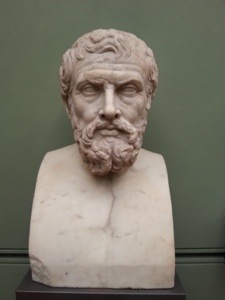 The two new rooms, 33 and 34 located right before hall 35 dedicated to Michelangelo, contain sculptures selected to highlight the works of classical antiquity that influenced Michelangelo’s formation as an artist. The rooms, which used to house works by 16th century Tuscan and Lombard painters before restoration, have changed dramatically. The first, 33, is dedicated to Greek Portraits while the second houses works that evoke those classical figures present in the San Marco Garden owned by the Medici where the very young Michelangelo at 13 years old studied classical sculpture.
The two new rooms, 33 and 34 located right before hall 35 dedicated to Michelangelo, contain sculptures selected to highlight the works of classical antiquity that influenced Michelangelo’s formation as an artist. The rooms, which used to house works by 16th century Tuscan and Lombard painters before restoration, have changed dramatically. The first, 33, is dedicated to Greek Portraits while the second houses works that evoke those classical figures present in the San Marco Garden owned by the Medici where the very young Michelangelo at 13 years old studied classical sculpture.
The green used for the walls of the two rooms was inspired by the green backgrounds often used in Paolo Uccello’s work in the 15th century and serves as a sharp contrast with the white marble sculptures. In comparison to the statues presents in the Corridors of the Uffizi, this background invites viewers to stop and study the features, frowns, noses and expressions of the people and scenes portrayed. There are no cords that set you away from the sculptures in Room 33 so you can go right up to explore them from various angles.
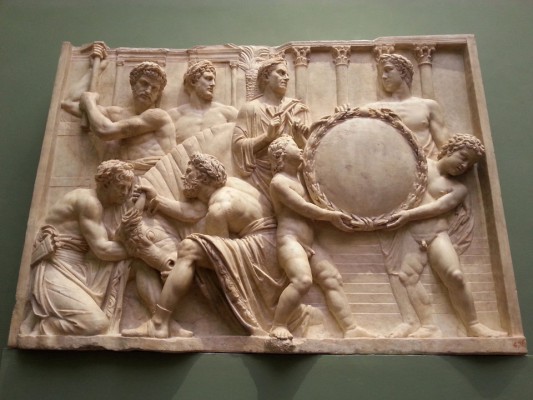
These classical works inspired artists – and the Medici themselves – of the Renaissance as models of perfection and character in the neoclassical era. The Garden of San Marco, in particular, created by Lorenzo de Medici and dotted with statues, portraits, sarcophagi and more was set to inspire the sculptors of the time to relearn what the ancient Greeks were capable of doing and to replicate that skill. Room 34 houses that type of work that led to Michelangelo’s great sculptural masterpieces which today can be admired at the Galleria dell’Accademia with his David, Prisoners and St. Matthew, his Baccus at the Bargello and his magnificent sculptures in the New Sacristy within the Medici Chapels.
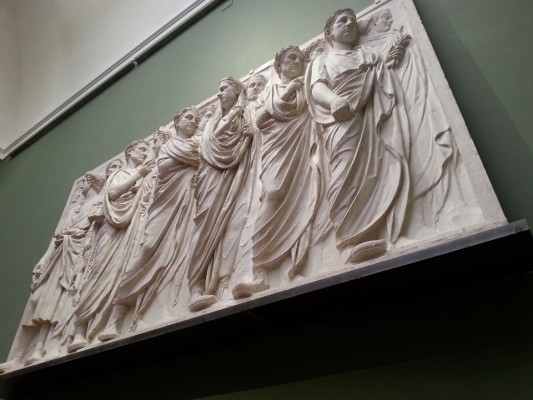
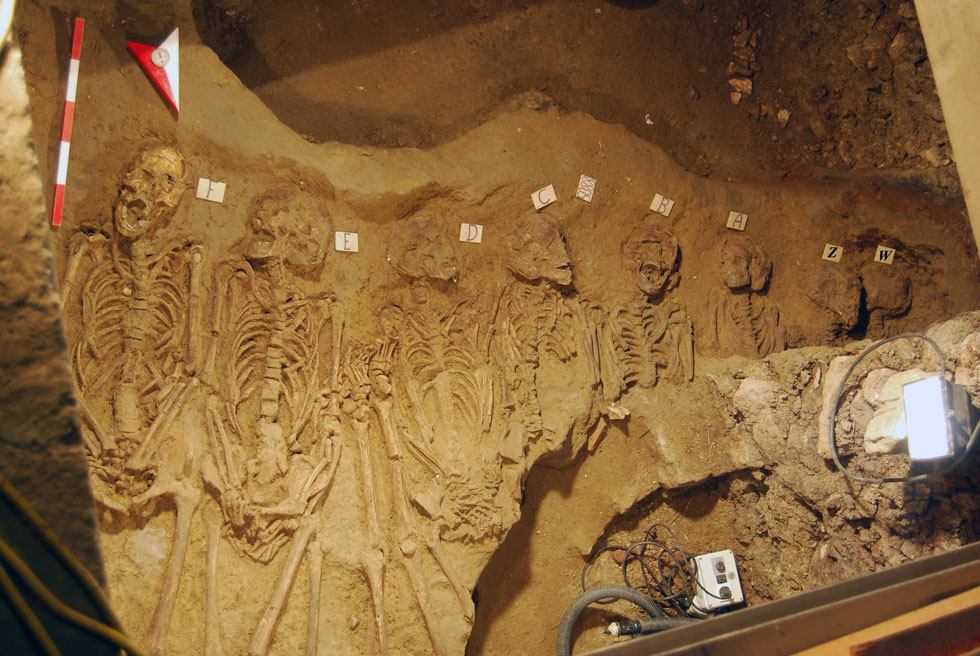
As work continues on the New Uffizi project, workers came upon human remains under the reading room of the Uffizi Library, right next to the Piazza del Grano. Over the last few months, scientists on the now archaeological site have determined there are about 60 skeletons from the 5th-6th century.
The findings reveal an important era of the city’s history, in the late Roman period when this area what located outside of the Roman city walls and continuously flooded by the river. Up to now, research had never revealed that the area has been lived on, actually it was often used as a dumping ground as pieces of construction material were the only things found when any type of digging went on (at higher levels). It might have been the growth of this material itself which made the earth in this area grow, when memory of the burial ground had been forgotten.
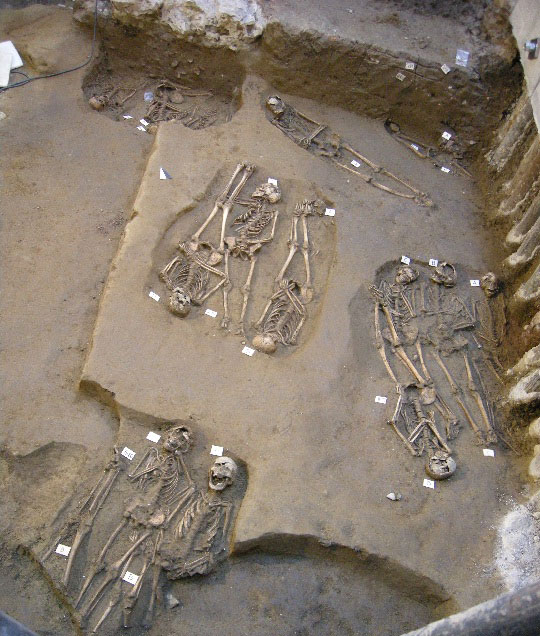 What the new findings indicate is that the area was used as an emergency burial place, likely as a result of an epidemic in the town. The way the skeletons are unevenly positioned, here and there with feet next to heads and very close to each other indicate they were done in a hurry and sought to make the most of the space available. Scientists thus believe it must have been a summertime epidemic, when the river was low and this area was revealed, soft with the river sediments deposited during the winter months when rain elevated the river.
What the new findings indicate is that the area was used as an emergency burial place, likely as a result of an epidemic in the town. The way the skeletons are unevenly positioned, here and there with feet next to heads and very close to each other indicate they were done in a hurry and sought to make the most of the space available. Scientists thus believe it must have been a summertime epidemic, when the river was low and this area was revealed, soft with the river sediments deposited during the winter months when rain elevated the river.
Studies will continue and hopefully reveal more about the actual cause of death and offer new ideas of what life must have been like in the Florence of many centuries ago. What we do know is that when Vasari constructed his Uffizi in this area he had most of the late medieval buildings destroyed, traces of which have also been found as work on the New Uffizi continues.









